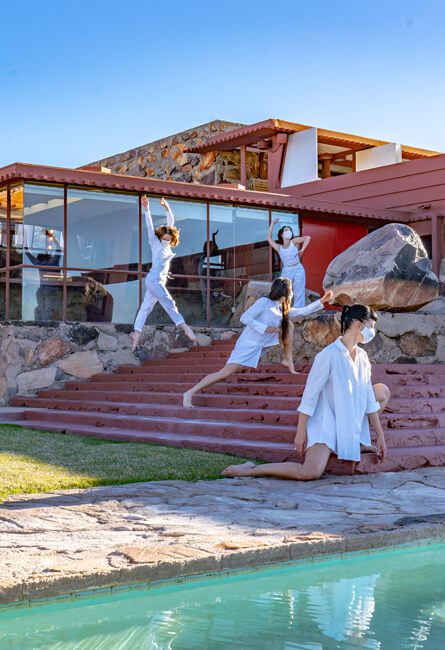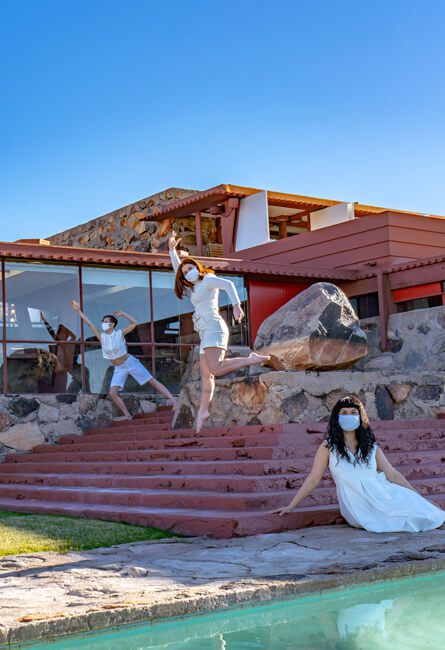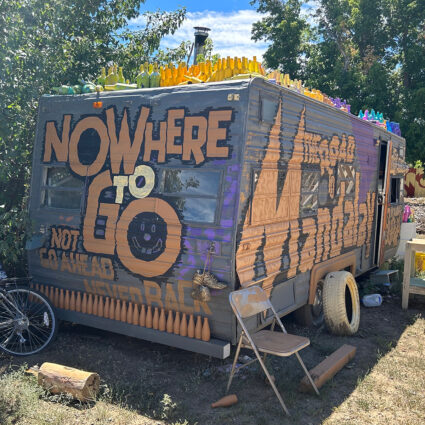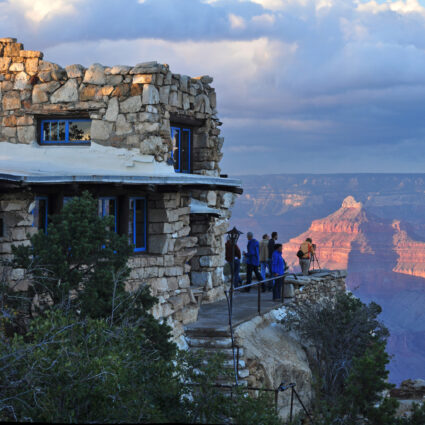CONDER/dance collaborates with the Frank Lloyd Wright Foundation at Taliesin West in Arizona to present new works by innovative choreographers in the Southwest.
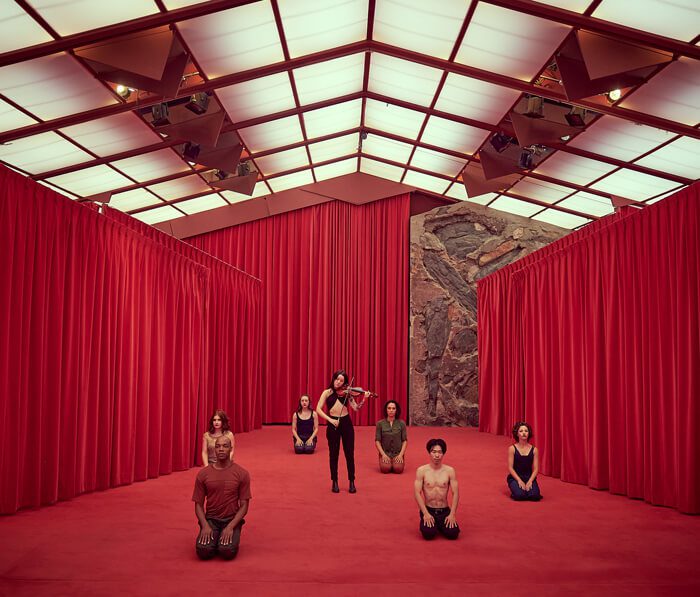
Choreographer Carley Conder first encountered Frank Lloyd Wright’s designs while growing up in Arizona. Family trips included visits to Taliesin West in Scottsdale, the winter home and design laboratory for the renowned 20th-century architect best known to many for the iconic spiral of New York’s Solomon R. Guggenheim Museum and his “organic architecture” integrating built and natural environments.
Decades later, those memories still resonate with Conder, as she choreographs and directs new works inspired by Wright’s life and creative process for a multi-year collaboration with the Frank Lloyd Wright Foundation, which is charged with preserving the legacy of its namesake, who died in 1959 at the age of ninety-one. Taliesin West has been in place since 1937.
“I remember my first encounters with Wright’s architecture very distinctly,” says Conder. “Being at Taliesin West now, I feel a real sense of history and the connections between the present and the past.”
We wanted to honor what we know and our own experience of this architecture that seems to rise out of a mountain towards the sky, including things like line, color, texture, scale, light, temperature, and smell. —Carley Conder
In March, the CONDER/dance company she founded in 2003 will present ten short dance works at Taliesin West, where dance was an integral part of both Wright’s family life and his Taliesin Fellowship apprentice program. “Wright felt that it wasn’t enough to learn to build architecture,” explains Alexandra Freyermuth, manager of cultural programs at the foundation. “Fellows also studied art and music and performed on a regular basis.”
It’s a history Conder knows well, after countless hours spent researching Wright’s body of work and the role that arts and culture played in the lives of Wright’s third wife, Olgivanna, and their only child together, a daughter named Iovanna. Both women were dancers. And both were significantly influenced by Russian mystic George Gurdjieff, whose philosophy relied heavily on movements he deemed sacred.
Before marrying Olgivanna, Wright garnered scandal for carrying on a long-term affair with a client’s wife, Mamah Borthwick Cheney. Wright built Taliesin in Wisconsin as their love nest, but it was also a site of profound tragedy. In 1914, while the architect was away, a servant murdered Borthwick Cheney and several others by setting fire to the living quarters and attacking them with an ax.
The complex intersection of Wright’s personal and professional lives informed Conder’s work, even as she focused on Taliesin West.
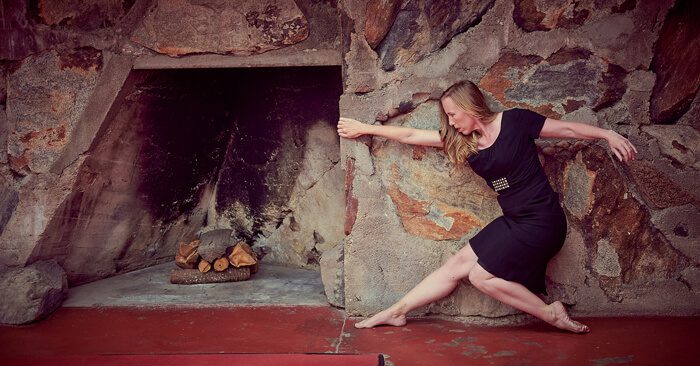
“We really honor the space,” Conder says of dancing where so many people connected to Wright have performed in the past. “To be part of its history in some small way is incredibly exciting.”
Conversations about a possible collaboration began in 2019. That’s the year Taliesin West, Taliesin in Wisconsin, and six additional Wright designs were added to the prestigious UNESCO list of World Heritage sites. They’d planned to present several performances in 2020, but that timeline got nixed when COVID-19 public health concerns led to a nationwide pause for numerous cultural, sporting, and other events. Eventually, of course, health and safety protocols made it possible for some cultural programming to resume.
By early 2021 they were ready to present the first of several CONDER/dance collaborations at Taliesin West, as part of its larger efforts to bring more cultural offerings to the site. For Taliesin West, the partnerships have several benefits, including making architecture more accessible and introducing Wright’s work to larger audiences.
“Architecture often feels removed to people, or people worry that they have to know a lot about architecture to enjoy it,” Freyermuth says. “Performances help community members experience Taliesin West without feeling like they have to be an expert, and draw in audiences who appreciate a wide range of art forms.”
Conder began by directing a production she called Anima in January 2021, which was titled after the idea of reanimating the performance space. Performed inside the Pavilion theater where Iovanna once shared her original works, it featured pieces by several choreographers and the premiere of Conder’s own in the direction of the unknown, a work referencing Iovanna’s historic dance productions and Frank Lloyd Wright’s drive for discovery.
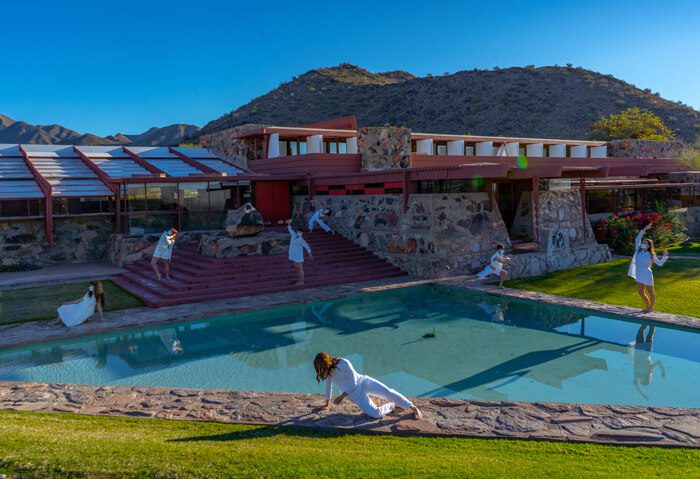
Then, in May, CONDER/dance presented a different Anima lineup inside the same theater, where walls made of wood, desert rocks, and concrete stand in stark contrast to the red carpet on the stage and the plush red curtains that frame it. The Pavilion theater is the main performance space at Taliesin West, but there is also a smaller six-sided space called the Cabaret theater where Ten Tiny Dances will happen on March 19, 2022.
It’s a format CONDER/dance first adapted several years ago for the annual Breaking Ground dance and film festival that Conder launched in 2007, which is performed at Tempe Center for the Arts. Basically, selected choreographers showcase five-minute pieces that dancers perform atop four-foot-by-four-foot stages, with lineups co-produced by Conder and Phoenix-based choreographer Nicole L Olson, founder and artistic director for MovementChaos dance company.
The March performance will be the second showing of Ten Tiny Dances at Taliesin West. For the first, dancers performed on the Prow, a triangular lawn where native plants fill geometric garden beds. For those Ten Tiny Dances in April 2021, choreographers drew from Wright’s biography, exploring his often-tumultuous relationships with women and ideas at the heart of his architectural designs. One dance explored the architect’s fascination with Japanese prints, and another his embrace of nature. One drew inspiration from Wright’s design for a Baghdad opera house, which was used instead for an auditorium in Tempe. Another was inspired by his mistress Mamah. Some movements conveyed discordance, while others amplified harmony. At the heart of it all is the grandiosity that paradoxically fueled both his design achievements and his personal failings.
This year’s Ten Tiny Dances will feature a new mix of choreographers, and every work will explore some aspect of Taliesin West. There’s plenty of material to work with, from desert structures designed by architecture students to bronze sculptures created by Heloise Crista, who once made costumes and did dance notations for performances at the site.
Examining Conder’s larger body of work, it’s clear that collaboration has been central to several of her recent dance projects. She choreographed both Gathering Light (2021) and Ecstasy of Betrayal (2021) in collaboration with the dancers who performed them, and worked with several additional creatives from visual artists to filmmakers. “I appreciate having other creative minds in the room,” Conder says of collaborating with fellow dance artists. “I come in with ideas and things like prompts, games, or exercises, then have the dancers generate movements.”
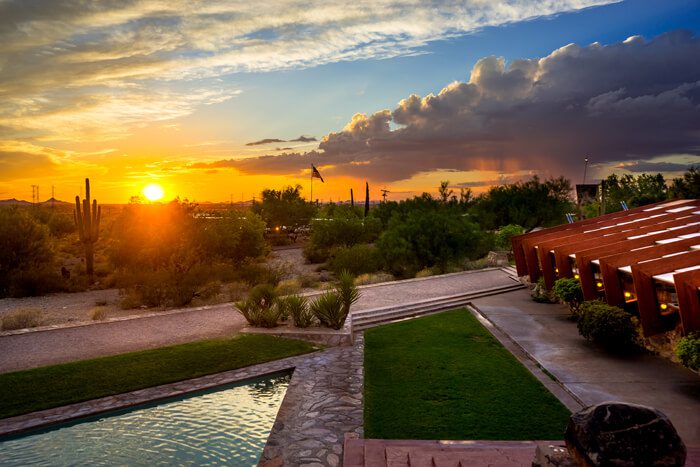
For pieces performed at Taliesin West, they’ve drawn inspiration from spending time at the historic site. “We wanted to honor what we know and our own experience of this architecture that seems to rise out of a mountain towards the sky, including things like line, color, texture, scale, light, temperature, and smell.” For Conder, desert rocks and stones used throughout the site have been particularly impactful, in part because they provide so many layers of inspiration.
Typically, Conder creates a new movement language for every piece she choreographs, and that’s certainly been the case with her work for Taliesin West, which reflects the visceral quality of her encounter with Wright’s philosophy and forms. “Here, there’s a sense of free flow and movement pouring out; the movement is circular and curved with a certain softness, but also a strong foundation,” she explains.
Making dance in the desert has been particularly gratifying during the pandemic, according to Conder. “Being able to have a live performance with an audience is very special and it’s something we don’t take for granted,” she reflects. “It’s been so celebratory and joyous to be a part of it, especially in this place where there’s so much history.”
